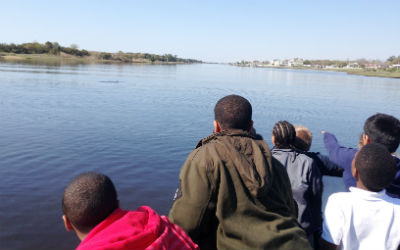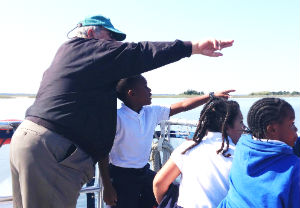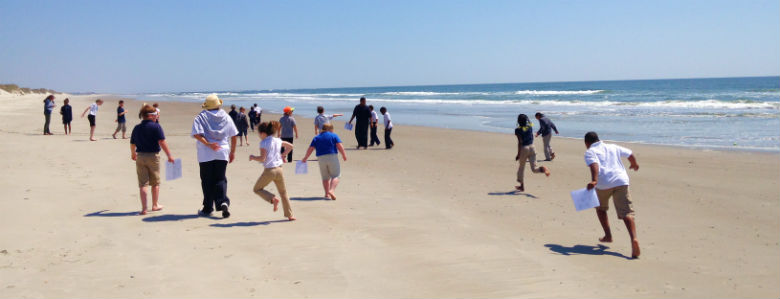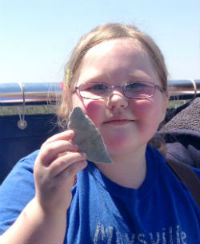 Students of Maysville Elementary catch sight of a dolphin on their field trip with the N.C. Coastal Federation to Bear Island. Photo: Tess Malijenovsky |
SWANSBORO – What better way to appreciate the Earth than to step onto the sand barefooted and see the expanse of an ocean for the very first time? It was something of an Earth Day for the third- and fourth-grade students at Maysville Elementary school on their field trip to Bear Island with the N.C. Coastal Federation. Although Maysville is less than an hour from the beach, many of the students have never been.
“Look!” A student shouts out, pointing to large ripples left behind from a dolphin.
Supporter Spotlight
The captain of the boat that ferries the kids to the island cuts the engine and the other 30 kids move to the bow. The graceful dolphin resurfaces closer to the ferry. The “whoa” and “wows” of the children fill the air.
“They’re, like, so beautiful,” says one young girl. It is the first time she’s seen a dolphin in the wild.
Since January, Rachel Bisesi, one of the federation’s educators, has been visiting the students at Maysville Elementary to teach them about coastal plants and how stormwater runoff pollution affects the health of the ocean. The students have been learning about ecosystems at school.
Today’s lesson at Hammocks Beach State Park is hands-on under a blue sky. For many of the students, it is their first trip on a boat or to the beach.
 The ferry captain helps a curious student identify a bird he’s never seen in Maysville. Photo: Tess Malijenovsky |
“This’ll be an adventure for a lot of them,” said Tina Trott, a teacher’s assistant at the school.
Supporter Spotlight
The students arrived at the park visitor’s center to begin their field trip with a presentation on sea turtles in the auditorium.
“Are those turtle shells real?” asks one student. The loggerhead turtle shells beside the ranger were more than half the student’s size.
Kim Valenti, the third-grade teacher, was pleased that the park ranger Jacob Vitak opened her students’ eyes to the possibilities of science careers.
“They need to know there are opportunities beyond Maysville. Mr. Jacob gave examples of what they could do, become scientists and solve the problems that they’re having right now,” said Valenti.
Maysville Elementary is the only primary school in Maysville in Jones County. Most of its students are from low-income families.
“These communities don’t always have an opportunity to experience the coast in ways that some other students may, and we want to make sure that they get the opportunity to have the same hands-on experiences,” said Bisesi.
 Third- and fourth-grade students of Maysville Elementary run wildly on the beach of Bear Island. Photo: Tess Malijenovsky |
 Lilly holds up what she discovered on the beach: half a sand dollar. Photo: Rachel Bisesi |
While its goal is to serve everyone, the federation’s educational program strives to work with underserved schools, said Sara Hallas, who has been a federation educator since 2008 at its office in Manteo. “By targeting some of the underserved communities it helps to inspire them to know that they can do things on their own without a lot of money or with very simple resources by just having the knowledge,” said Hallas.
After the exciting dolphin siting, the students gathered under a gazebo on Bear Island and listened to Bisesi talk about some of the items she collected from the salt marsh nearby: a clam shell, mussels, oysters, a fiddler crab, an oyster drill, a periwinkle snail and sea lettuce.
“I’ve learned a lot about the animals and what different shells are besides just being shells,” said student Michael Meadows who had never seen a mussel shell before.
“They don’t associate clam with the shell,” said Tina Rappaport, one of the parents on the trip. “Seein’ the stuff that they see all the time, it doesn’t come from Food Lion.”
It’s important that the students make this connection to the environment, Rappaport says, because “that’s the future.”
“They’re the ones who have to protect it later on, so if they don’t know where it comes from they take it for granted,” she said.
 No small animal track goes unnoticed as the students marched to the ocean-side of Bear Island. Photo: Tess Malijenovsky |
Simple things like ghost crab holes don’t impress most adults much or perhaps we often take them for granted. The children, however, let no small animal track or “evidence” go unnoticed as they marched to the ocean-side of the island. Along the trek, federation volunteer Donna Snead would stop the group to talk about the different plants and the animals that depend on them to survive in the beach ecosystem.
After a picnic lunch, the students braced themselves for “free time” on the beach: wiggling out their excitement, taking off socks and shoes and then being on their best behavior to get the teachers’ approval. A single file line down the wooden railing quickly derailed into kids running in every direction on the beach like 30 pinballs in one machine. Some stayed in groups playing the federation’s beach scavenger hunt; boys discovered an over-sized tennis ball in the swash zone to play catch with; others collected seashells by the dozens.
“This is the best field trip ever!” said student Michael Meadows.
“This is something a lot of them will remember for a lifetime,” said Jacqueline Lanier, the fourth-grade teacher.







